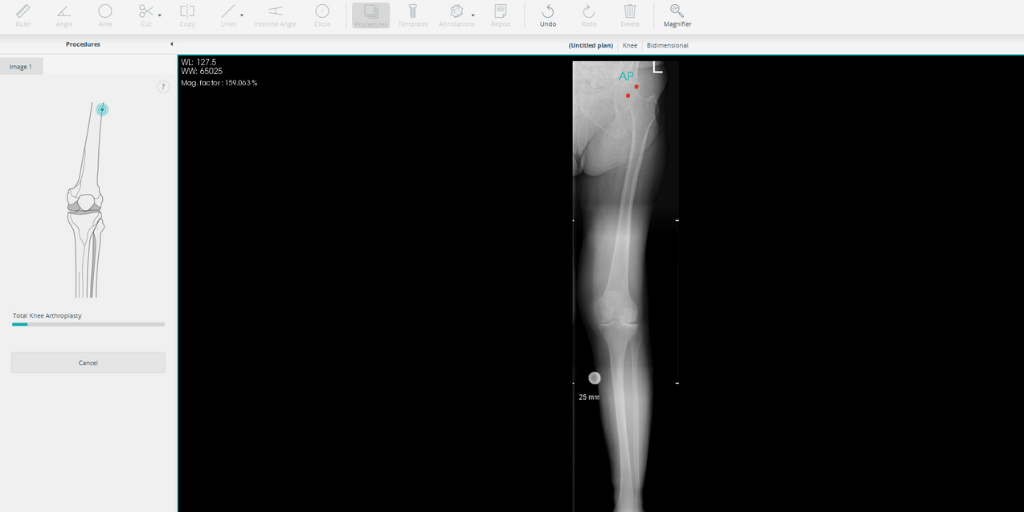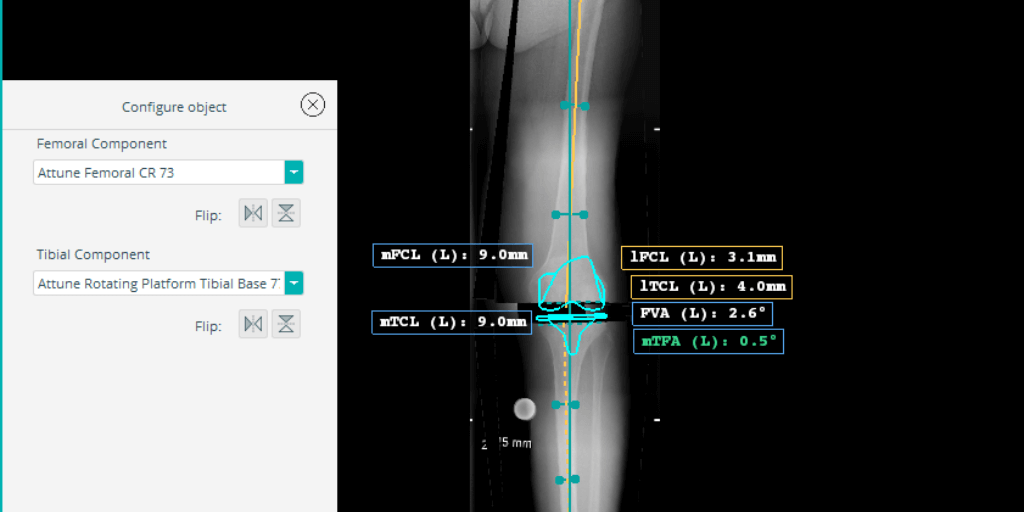PeekMed
Arthroplasty of the knee – also referred to as Total Knee Arthroplasty (TKA) or Total Knee Replacement – is a common procedure to address issues related to knee pain and related medical conditions. In academia, this procedure has also been coined as Total Knee Arthroplasty Pathophysiology.
While being essential, TKA pathophysiology procedures used to take a considerable amount of time for surgeons. However, MedTech brought new, more efficient ways how to perform total knee arthroplasty.
Surgeons can now combine computer-assisted total knee arthroplasty and use patient-specific templating to improve surgical outcomes.
To help you with how to perform a TKA surgery and take advantage of technology while doing it, we prepared a comprehensive guide. In this article, we will touch on topics such as:
Why use preoperative planning for total knee arthroplasty?
The American Academy of Orthopaedic Surgeons (AAOS) has pointed out that 60% of surgical errors could be avoided with preoperative planning.
Knee surgery preoperative planning matches this idea, as it is excellent at predicting the size of primary prostheses when preparing to replace the knee joint.
This is of extreme importance, as when not correctly planned, joint replacement surgery leads to issues such as soft tissues, cartilage, and, bone damage.
Thus, even several weeks after surgery, patients still report complications that cannot be addressed by pain medications or physical therapy.
These reduce the range of motion of the patient – making day-to-day actions, like climbing stairs, a challenging task.
A common consequence is the need to provide a revision total knee arthroplasty procedure when it shouldn’t have been needed.
Said problems are often related to choosing the wrong size of an implant, which can easily be avoided by knee templating.
On top of that, there's the economic side.
Preoperative planning allows you to ensure you have the right amount and necessary sizes on demand, ready for your surgery.
This decreases the need for a wide range of extensive and less used stock to be kept on-site, resulting in greater cost efficiency.
Preoperative planning of a TKA can be made easy with the right tools, allowing surgeons to automate several steps. Bellow, you will find information regarding how to do a TKA step by step.
Total Knee Arthroplasty procedure steps: how to perform with PeekMed
Total Knee Arthroplasty surgical procedures can be made simple, allowing surgeons to, at the same time, speed up the process, save resources and make it even safer for patients.
Imagine you wanted to perform a right total knee arthroplasty on one of your patients. Do you know how to take full advantage of knee preoperative planning and technology?
PeekMed allows you to automatically perform tasks such as measurement implant implantation selection using Artificial Intelligence technology.
Bellow, you will find more information on how it can be done.
How to Measure for Total Knee Arthroplasty templating automatically
As you know, measurements are a very important part of the surgery before moving to total knee replacement surgery. But with PeekMed your life is made much easier.
The first step will be to upload and quickly calibrate your patient image – which PeekMed can also do with just a few clicks.

After selecting total knee arthroplasty in the procedures list, PeekMed will guide you while you mark the points in the patient images.
These positions of the points may be changed at this stage. To do this, simply click on each handle with the left mouse button and move them to the most suitable position.
When this step is concluded, all of the following measures will be shown automatically:
-
Mechanical Tibiofemoral Angle (mTFA): the angle between the line from the center of the femoral head to the center of the femoral articular surface and the line from the center of the tibial plateau to the center of the tibial distal articular surface;
-
Lateral Femoral Cut Length (lFCL): a lateral length in the femur to perform the resection;
-
Lateral Tibial Cut Length (lTCL): a lateral length in the tibia to perform the resection;
-
Medial Femoral Cut Length (mFCL): a medial length in the femur to perform the resection;
-
Medial Tibial Cut Length (mTCL): a medial length in the tibia to perform the resection;
-
Femoral Valgus Angle (FVA): the angle between the mechanical and anatomical axis of the femur.
To show this procedure, PeekMed needs additional references:
-
Mechanical Axis of the Femur (MAF): femur length, the length between the center of the femoral head and the midpoint of the femur plateau;
-
Anatomical Axis of the Femur (AAF): line from the center of the proximal femur to the center of the distal femur;
-
Mechanical Axis of the Tibia (MAT): tibial length is the length between the tangent line of the tibial distal articular surface and the midpoint of the tibial plateau;
-
Anatomical Axis of the Tibia (AAT): line from the center of the proximal tibia to the center of the distal tibia;
-
Mechanical Axis (MA): total leg length, the length between the center of the femoral head and the tangent line of the tibial distal articular surface.
After the measurements, automatic templating is performed by PeekMed.
How to Preoperative Templating for Total Knee Arthroplasty Automatically
When planning a knee arthroplasty surgery with PeekMed it is possible to perform the automatic templating of the femoral and tibial components. To do so, the system will use the points marked by you, and the measurements done by the system.
Auto templating for TKA detects the templates that better match the femoral and tibial components’ widths and places them in the planning view, with the expected alignment.

This feature automatically finds the closest templates and places them according to the tibial and femoral lengths.
The auto cut aims to restore the patient’s femoral and tibial anatomical alignment, by performing a femoral and a tibial cut and moving until their axes are aligned.
In the object edition, you can perform the auto templating and the auto cut simultaneously or separately, simply by selecting the respective options and clicking finish.
PeekMed will automatically add the selected templates to the planning and/or perform the cut. If the auto cut has been made before placing the templates, the templates will consider the cut. If the cut has been made after placing the templates, the templates will alter their position according to the cut’s movement.
You can change the selected templates and their configuration in the objects section, by clicking on the template’s configuration icon. It is possible to change the templates via the “update list” buttons.



